Fall is here, and I would like to offer a review/interpretation of one of my all-time favorite movies, one that takes place entirely in the fall.
Before I get started, I would like to mention that my Cousin Ronald will be back for more political commentary some time next week, but seeing as how he “ain’t just some lazy goodfornothing what sits in front of a durn computer all day,” and that he “acktuly has a famly and a job to keep up with,” it may be a little longer before he writes another “web blog” post. He wanted me to tell you all that he looked at your comments on my Facebook page, and he didn’t see what was so “gall durn funny” about anything he wrote, but then again he “wasn’t no damn Godless heathen libral,” so it wasn’t surprising that he didn’t know what “Godless heathen librals” would find funny. He told me to tell you he was praying for you all.
If anyone reading has any questions for Cousin Ronald, or would like to read his opinion on any given issue, inquiries can be made to his email address:
cousinronald72@gmail.com
He also wanted me to mention that that email address isn’t his real email address, it’s just the one he will use for “web blog” purposes, seeing as how he doesn’t want to be associated with anyone who is already associated with, well, me.
Moving on.
Since I have already written about 200 words concerning something other than the actual subject of this blog post, I will insert a header here, one that is identical to the title, using some basic html commands. I am new to this, so I need all the practice I can get. So anyways, to remind the reader of the subject:
AN OCCURRENCE AT MIDDLESEX RIDGE SCHOOL — DECONSTRUCTING “DONNIE DARKO”
For purposes of this blog post, I am assuming that the reader has seen the movie already. There will be multiple spoilers, so if you haven’t seen the movie, you might want to watch it before you read this. Or maybe not, I really can’t say. “Donnie Darko,” in my opinion, is a movie that can be watched and enjoyed multiple times.
It should be noted, however, that the version of the film I am reviewing is the original 2001 version, not the “Director’s Cut” that was released in 2004. The IMDB default image for the movie title is from the director’s cut, not the original. Here is the DVD cover of the version I personally own, which I procured for five bucks in a discount bin at my local Walmart a few years ago.
And as the reader can tell, the webcam on my laptop is not what anyone would call high quality. That’s fine by me, as a matter of fact I cover my webcam with a square piece of a blue Post-It note 99% of the time anyways. But I am digressing.
I want to say first that I am only “deconstructing” this film in a fairly superficial sense. I intend to take certain elements of it apart and view them in relation to each other, but not in any sort of seriously academic sort of way.
So if some college student out there who happens to be a fan of “Donnie Darko” finds this blog post, I wouldn’t recommend that they use it as a source for any paper they intend to turn in for a grade. But who knows, maybe I will provide some insight or other that they failed to think of on their own.
Moving on.
I would like to explain the title of this post: it is a reference to a film I saw as a freshman in a film lecture class at the University of Arkansas many long years ago. The class was taught by Thomas Frentz, who I hope will not mind my mentioning his name here on my blog. His film lecture class was one of my all-time favorite classes during my six years as a student at the U of A, and I have a lot of respect for the man. However, if he wishes, like Cousin Ronald, to not have his good name sullied by association with the likes of me, I will remove it from this blog post.
What I want to express, however, is that his class had a profound effect on me as a movie-goer. After taking that class, I was no longer able to simply watch a movie passively. Every movie I saw following that class had to be taken apart and studied. And on the one hand, this approach to movie viewing has given me the ability to appreciate movies on a much deeper level than I ever had before.
But on the other hand, it made me much more critical of movies, in such a way that many wildly popular movies became simply painful for me to watch. I suppose that was a fair trade-off, but following that trade-off, I don’t think that I would be a very fun person to go to the movies with. And here I am digressing again.
The title of this blog post is a reference to a short film titled “Occurrence At Owl Creek Bridge,” based on a short story by Ambrose Bierce.
In the film, a man — more specifically, a soldier of some sort — is about to be executed by being hanged from Owl Creek Bridge. He stands on the bridge, a noose around his neck, and he walks out on a plank. Another soldier is standing on the other end of the plank. The executioner soldier steps off of the plank, and the man falls.
When he falls, somehow, the noose slips from around his neck, and he falls into the creek below. He swims to the creekside, frantically, while shots are being fired at him from soldiers on the bridge. Somehow he manages to escape, but he does not stop running. The remainder of the short film consists almost entirely of him running. Towards the end, he sees a woman’s face — presumably that of his wife, girlfriend, or even possibly his mother — and he ends up very close to what the viewer can only guess is his home, a large house with (I believe) the woman standing out front, her arms open, ready to embrace him.
And just as it seems like he is about to embrace the woman — or maybe just as he embraces the woman; as I said I only saw the film once, and I think that was in spring of 1999 — the film abruptly cuts back to Owl Creek Bridge, where the man is shown hitting the end of the rope, which he never actually slipped free of. The majority of the film actually occurred entirely in the doomed man’s mind, in the second or so between when the executioner soldier stepped off the plank and the doomed man reached the end of the hangman’s rope.
In other words, the majority of the film was merely a frantic sort of waking dream that the doomed man was having at the instant of his death.
I am not certain if “Donnie Darko” director Richard Kelly was consciously paying homage to “…Owl Creek Bridge” with “Donnie Darko” — the DVD commentary track from the DVD pictured above suggests that he may not have been — nonetheless the two films are quite similar.
On the DVD commentary, Kelly points out several minor details that most viewers — even self-described “critical” viewers such as myself — might not notice, even after multiple viewings. For example, after Donnie wakes up on the side of the road at the beginning of the film and rides his bike home, the red car he passes

is the same car that runs over and kills Gretchen Ross near the end of the movie. This car belongs to Frank, who we find out at the party scene near the end, indirectly,

is dating Donnie’s older sister, Elizabeth.
Another detail that even a self-described “critical” moviegoer such as myself missed was that Donnie wrote a letter to Roberta Sparrow (a.k.a “Grandma Death”), and this is what caused her to be in the street just as Frank happened to be coming back from his beer run, just as Gretchen is lying in the middle of the road. If “Grandma Death” hadn’t been standing in the middle of the road as a result of her finally getting a letter — recall the scene from earlier in the movie where one of Donnie’s jackass friends says “somebody ought to write that bitch”? — Frank would not have swerved to miss her and accidentally run over Gretchen.
And Donnie wouldn’t have shot Frank in the face.

Of course, even a casual viewer could pick up on how Frank’s eye has been shot out when he appears in the theater earlier in the movie
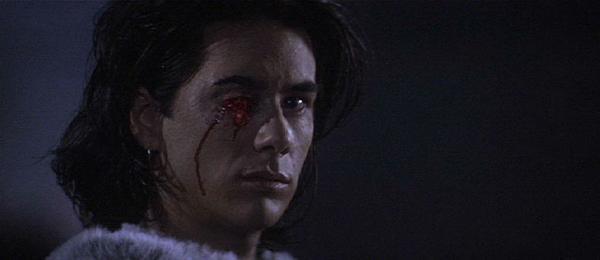
or how when Donnie is taking his pills and Frank appears, Donnie is stabbing Frank in the same eye that is shot out later.
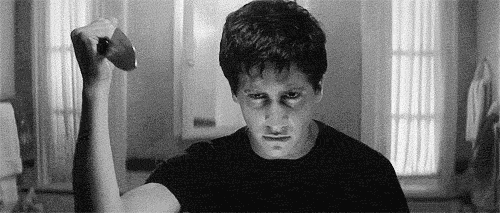
But there are things Richard Kelly mentions in the commentary, such as how Donnie has to bring an “artifact” to a certain point — I am not certain if this “artifact” is the jet engine

that detaches from the plane Donnie’s mom Rose and younger sister Sam are flying on, or if this “artifact” is Gretchen’s dead body — that suggest that maybe Kelly was actually promoting the whole “Philosophy of Time Travel” aspect of the movie as a real thing (at least within the movie itself) and not…well, I would rather not say just yet.
There’s also the matter of the weird “Abyss“-looking things that I can’t find a gif of. You know, like when Donnie, his dad, Dr. Fisher, and Dr. Fisher’s jackass bigot son Ronald are watching football, and Sam is skipping around following that weird watery-looking thing coming out of her chest, and then one of those things comes out of Donnie’s chest, and he follows it upstairs and finds the gun he ends up shooting Frank with? Remember that part?
“I hope they go for a safety.”

Really, Ronald. Shut up. Stop talking. Jackass.
But wait…my bad…it was Donnie’s other jackass bigot friend Sean who told Cherita to “go back to China.”
Donnie had shitty friends. No wonder he had emotional problems.
Anyways, what I am getting at is that there are a lot of things in the movie that simply don’t make a whole lot of sense, strictly speaking. And as the movie progresses, things get weirder and weirder.
The movie isn’t really all that weird at first, not counting, I guess, that the protagonist wakes up on the side of the road at the beginning,
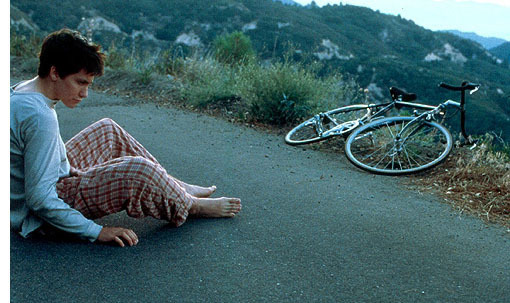
but after Donnie takes his pills, which the viewer can only assume have something to do with his sonambulism, the movie gets stranger and stranger. He doesn’t see Frank until after he takes a pill for the first time, and after that, more and more weird things start happening.
It is my opinion that Donnie takes the pill, goes to bed, and begins dreaming. And the rest of the movie is a dream, not counting the very end where it shows Donnie’s family crying and firemen removing the jet engine from the house and whatnot.
“Sit next to the boy that you think is the cutest.” I mean, come on! Where does that sort of thing happen, outside of a teenage boy’s dream?
It’s also somewhat important that his mother pressured him to take the pill. She was no doubt acting in what she thought was the best interest of her son.
But what happened, at least in the original version of the film (in the director’s cut, the pills were revealed to be placebos), is that after feeling guilty for calling his mom a “bitch,” Donnie decided to take her suggestion and take the pills his psychiatrist Dr. Thurman had prescribed.
And that night he didn’t sleepwalk.
And that night, by some (probably physically impossible) freak accident, a jet engine falls from the sky and lands directly on Donnie, killing him.
The remainder of the movie is, essentially, a dream. But unlike “…Owl Creek Bridge,” it isn’t just the protagonist having the dream. Every character in the movie — or at least the ones shown waking up in the final sequence — is sharing the dream.
Isn’t that hilarious?
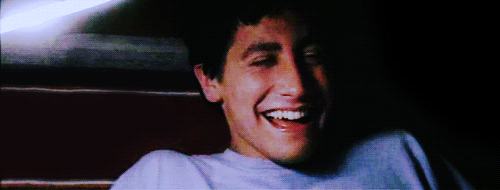
…but I might be all wet. At any rate, “Donnie Darko” is one of my all-time favorite movies.
“S. Darko,” however, is terrible. Just awful.
Sorry, Sam.

Thank you for reading.
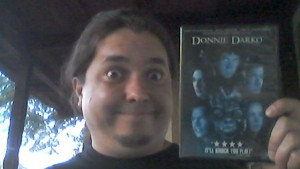
Leave a comment